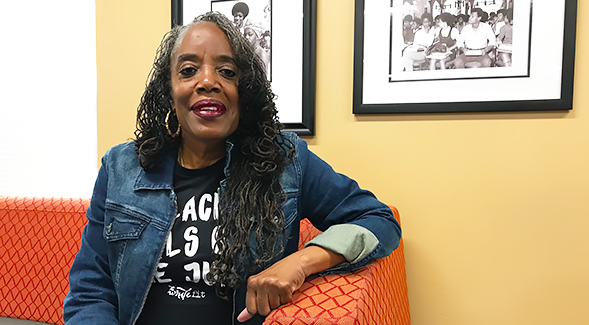Building Toward the Future: Q&A with Bonnie Reddick
Bonnie Reddick, interim director of the Black Resource Center, says purposeful and engaging educational programming fosters student success.

“The work of the center serves to equip students to be successful in their academic pursuits, and beyond.”
Bonnie Reddick’s drive to advance educational equity finds her teaching inside and outside of the classroom at San Diego State University.
In addition to being a lecturer in the Africana Studies department for the last 18 years, Reddick also serves as the interim director of the Black Resource Center (BRC).
But that is not all.
She assists Tonika Green, SDSU’s Charles Bell Scholar, who oversees the Henrietta Goodwin Scholars Program. The program provides support around academics, socialization, community engagement and professional development for black students.
Reddick discussed what motivates her to engage in educational programming that fosters student success, and the importance of a connected and supported black community on campus.
As interim director of the Black Resource Center, what inspires you to do this important work day in and day out?
I am inspired by the countless black men and women, named and unnamed, who were stolen from their homeland, endured the Middle Passage and subjected to the most brutal and barbaric system of enslavement known to man. They survived Jim Crow and the violence of the Civil Rights Movement. They endured America’s broken promises, relentless police brutality, and blocked access to opportunities, yet they kept their eyes on the prize to create a better tomorrow for those coming after them.
Black students only comprise 4% of SDSU’s population. They sometimes experience isolation, discrimination and racism, but still they persist. The Black Resource Center was birthed in response to black students’ demands for a safe space that affirmed their personhood, where they could support and nurture one another, and study and connect with others in the black community. It is my job, and that of my staff, to ensure that we are developing programs that educate and affirm the substantial contributions of black people globally to black students, faculty and staff. The work of the center serves to equip students to be successful in their academic pursuits, and beyond.
SDSU places high importance on the values of diversity, equity and inclusion. Why are these values important to you as a person and educator?
Diversity, equity and inclusion are extremely important; however, they must encompass more than quotas and a professional development class. It must become entrenched into our core values, and it must be illuminated in everything we do. In the last two years, I have witnessed SDSU transform the culture of diversity and inclusion.
The Division of Diversity and Innovation created Employee Resource Groups, Professors of Equity and established additional identity centers, for example the Latinx Resource Center and the Native Resource Center. These are all positive steps in fostering a diverse and inclusive campus.
The BRC is also doing our part in promoting diversity, equity and inclusion. Last semester, we partnered with Arts Alive SDSU and the Music Department in hosting Joel Thompson, who produced a symphonic piece addressing the multiple deaths of unarmed, black men in this country. We hosted a panel to discuss the trauma of experiencing these deaths and positive ways to respond to it. Students and faculty engaged in a vulnerable and candid conversation that was mutually beneficial. We will continue to seek opportunities to collaborate with our campus partners in similar ways.
The Black Resource Center connects students, faculty, and staff on so many levels—academically, socially and politically. Why is building a connected black community important on campus?
Building community is important because we live by tenets of the African proverb: “I am because we are, we are because I am.” None of us have experienced success in isolation. We stand on some pretty broad shoulders. The elders in the community need to model this commitment to the students. We need them to divest from an individualistic and fixed mindset to a pluralistic and growth mindset.
The BRC’s motto is “Team Work Makes the Dream Work.” We lead with intention and we lead with the heart. The BRC is being intentional and purposeful in strengthening our community partners. For Homecoming Weekend, we partnered with the African American Alumni Chapter to host a Friday night social. Many of them had not been to the BRC, so it was an opportunity to showcase what we’re doing, and it was a time for alumni to connect. The next day, we and the Alumni Chapter hosted a breakfast for undergraduate students, and the Alumni Chapter gave out eight scholarships. The alumni engaged with the students, and many of them volunteered to be mentors.
What excites you most about the Black Resource Center and its work moving forward?
I am excited about the programming we produced last semester, including celebrating three black faculty who were promoted to full professor, one of whom is my colleague and Charles Bell Scholar Tonika Green. I am also excited about our Black History Month programming. In the future, I am looking forward to developing purposeful and engaging educational programming and continuing to strengthen our relationships with our campus and community partners.



